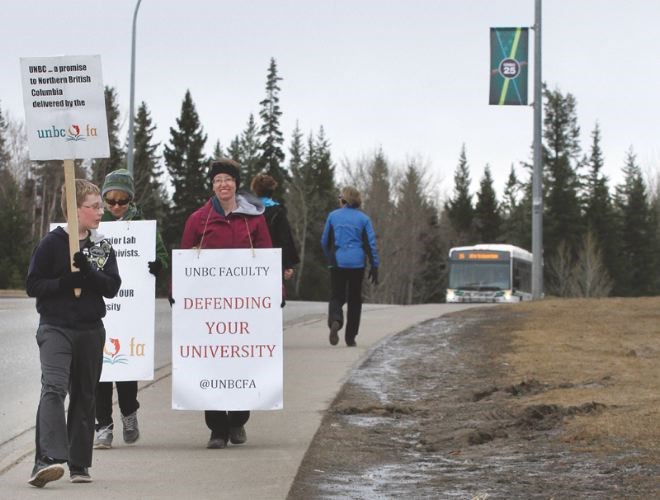More often than not stories present a diversity of opinions on a given subject, often opposing. Rarely is that more apparent than the "he said, she said" reporters must navigate in the midst of job action.
But with a strike, ultimately the two (or more) sides have a common interest. With UNBC, it's the success of the institution; they just have different approaches (some would say priorities) to arrive at a similar end.
As much as possible, it's important to get to the root of the dispute, in this case compensation. It doesn't matter that the sides settled dozens of contract articles if we're still seeing picket lines.
It helped that the university acknowledged the wage gap exists. It also helped that arbitrator Vince Ready had previously published an independent review of the positions.
Unfortunately, the numbers change depending on what side you're talking to. As a reporter, it can be impossible to offer a true comparison to readers when both sides arrive at their numbers differently, making it difficult to fact check.
For example, the university has said the faculty's initial proposal would cost $20 million and later adjusted to $18.9 million. Faculty said that number was misleading, in part because it counted positions that weren't filled. But we can't examine the faculty's arithmetic, because it hasn't been made public.
The university says its offer will cost $4.5 million. The faculty won't say the cost of its proposal.
Some faculty won't get a raise, it says, while some are 20 per cent off their colleagues across Canada. We don't know how much of that gap must be closed for it to be acceptable to faculty.
The university offers a general wage increase, the faculty talks about re-mapping salary structure. Apples and oranges.
Simply put, there are a lot of unknowns that asking the right questions won't get an answer because of another aspect to covering strikes: the reluctance to bargain in the media.
While neither side will admit to the tactic, it's equally true that all we're getting is what each side is willing to make public.
We'd be fools - as reporters and readers - to think we're privy to the same conversations at the bargaining table and that each side isn't counting on the support of public opinion.
Crossing the picket line is its own adventure. The Prince George Citizen is a union shop, which is to say, we don't cross picket lines. Two stories during the strike justified the request, when students marched the hill to speak with president Daniel Weeks, and when students staged a sit-in.
In both cases, reporters spoke with the picket captain for permission and were waved across. If we'd been denied, we would have drove back down the hill, but would that have justified its own story?
The easy mistake is to get caught up in the minutiae of proposals and counter-proposals from the two sides, forgetting both the students and other perspectives within each group.
When presenting views of the institution, the faculty, and the students, we can fall into this idea of false consensus. Although an 85 per cent faculty majority voted for a strike mandate, there's still that 15 per cent who thought different. The CUPE workers, also on strike, are unlikely to speak against the action.
A false consensus also appears if you're searching the same spaces.
Social media for reporters is a valuable tool to connect with those affected, find out about demonstrations organized online, or watch students upload protest videos to YouTube.
The #unbcstrike hashtag flooded my feed with faculty support but that chorus doesn't necessarily represent the diversity of the student - or faculty - population. It just represents the voices online, with easy access to internet or smartphones. That's not to say the support isn't there, but that it can't be used as absolute proof.
There were those few students who were critical of the faculty, the timing of the strike, and the manner in which students were encouraged to get involved. All refused to speak on the record. They'd seen their professors visible and outspoken on the picket line, and feared how their opinion would impact that relationship.
Many faculty would likely be insulted by that inference but it is fair to acknowledge that power differential exists.
Whether or not the students were right in their reluctance, I didn't quote any of them. Was that the right decision?



